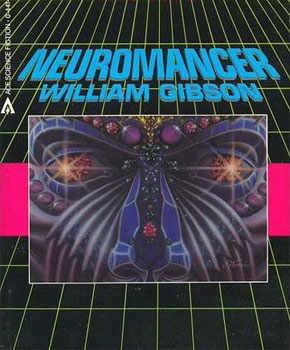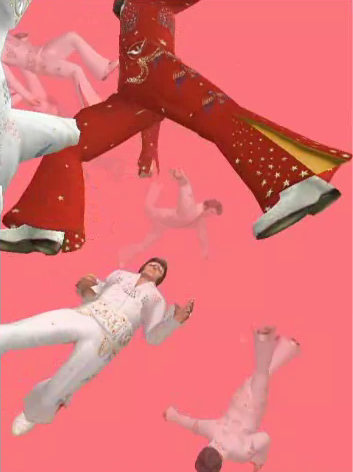
Scheduled for its New York premiere this Sunday, November 22, Case is an experimental adaptation of the 1984 novel Neuromancer by William Gibson. Considered a classic work of the literary genre cyberpunk, Neuromancer tells the story of Case, a fallen super hacker whose glory days have long since ended, leaving him in a drug-addled, regret-ridden state that lifts when a mysterious entity offers him a second chance. Charged, kaleidoscopic, and prescient, Neuromancer dilates on virtual reality, artificial intelligence and a globalized world through the intricacies of Case’s story. Case (2009), conceived and produced by artist Brody Condon, will be a day-long installation and performance that, in the artist’s words combines “Gibson’s 1980s dystopian techno-fetishism with faux ‘virtual reality’ scenes that will unfold via moving Bauhaus-inspired sculptural props accompanied by the Gamelan ensemble Dharma Swara.” I asked Condon a few questions in advance of the New York premiere so readers, near and far, could get a sense of how this ambitious work will unfold on Sunday.
Case is commissioned and presented by Rhizome and Performa 2009: the New York Biennial of performance art, whose theme this year is futurism. It will take place at the New Museum on November 22 from 1-6pm. Viewers may come and go; there is no set time required to stay. Advance tickets are available here: http://www.newmuseum.org/events/384.
Lauren Cornell: Why were you inspired to adopt Case's story in 2009?
Brody Condon: One core theme of Gibson's novel is addiction and transcendence, and is embodied by the hacker Case. The performance will feature Ray "Bad Rad" Radtke, an infamous Midwestern hell-raiser and activist, reading as the main character. This work started as a series of interviews with Ray, which I mashed with Neuromancer. Not only did he give me this book in the late 1980's, but many of his anecdotes concerning a life lived on the fringes of society blend seamlessly with those of Case.
I'm actually not so interested in the specifics of Gibson's narrative, for me the book is a reference to a situation that surrounded me in the 1980's when "new age" spiritual culture combined with a technological fetishism that promised a now dated "virtual reality" that would finally release us from the confines of our bodies.

LC: Right, when characters interface with the internet in Neuromancer, it is like they are stepping into virtual reality. This is not the first time you've dealt with alternate realities -- a fascination with them runs through your work, as with Twentyfivefold Manifestation (2008) in which 80 players enacted live action fantasy role-playing in a sculpture park over the course of a few months, and KarmaPhysics (2004) which features animated Elvis’ falling through an unbounded, pink-hued space. How will this feeling of virtual reality be conveyed in the performance at the New Museum?
BC: I'm almost embarrassed to admit that I am still interested in this notion of projection of self into other spaces via religious experience, drugs, role-playing, or immersive screen spaces, but I never imagined Case interfacing with the actual internets, he is immersing himself in Gibson's idea of what he thought this future screen space could be - the most lucid take I've heard recently on this issue is Bruce Sterling's talk in Germany, "the idea that the virtual is somehow philosophically seperate from the actual, it's a period notion. It's done."
The piece at the New Museum is a parody of this idea of a space where we would fly through information. When the main character, Case, "jacks in", he will face away from the audience, the Gamelan ensemble will kick in, and the other readers will pick up the geometric props and move around him, like he is flying through the virtual objects as described in the novel. At the same moment, the props are similar to objects used in Oscar Schlemmer Bauhaus performances, a key moment in early twentieth century techno-fetishist art.

LC: The performance combines sensationalism and deadpan readings. The narrative itself is thrilling and wild--reading it today, one can't help think about how its future predictions have borne out. And you've selected a truly diverse cast from much-loved Williamsburg gallery owner Sto of Cinders Gallery to actress and actress/ pornstar Sasha Grey. Can you describe what visitors will see when they come to the event on Sunday? And more practical choices: how did you do the casting? And why did you choose to have the reading be deadpan?
BC: I don't find the performance so sensational, or at least I didn't begin with that intention. Viewers can come and go as the please throughout the day. The event will be fairly random and casual, like a rehearsal, with the Gamelan ensemble interrupting the monotonous reading at various cycles throughout the day during the scenes where Case is in other spaces outside his body like hallucinations or VR. I have made a set of geometric shapes inspired by video documentation of a 80's Oskar Schlemmer remake where two dancers interact with a stack of cubes. Made in collaboration with the printmaker Breanne Trammell, the shapes will be picked up and moved around Case as a low-fi VR simulation.
LC: Via his Twitter account, we found out that William Gibson approves the performance and has no issue with the fact that you didn't seek his permission in advance of the production. This isn't the first work in the public domain you've dealt with, what is your usual approach to ascertaining permission?
BC: Copyright law is broken. Creative consumption and modification of existing media is a totally intuitive and appropriate way to function as a cultural producer. That is not to say I function without any honor system whatsoever, I give credit where it is deserved... and it's an honor that Gibson is into the project.
LC: Agreed. Last question: Where will Case go next?
BC: From the beginning the idea was to stage the reading at a small outdoor theatre in the rural Midwest where I originally began shooting interviews with the main character Ray a few years ago. That is currently planned for 2010. I am re-staging it primarily to shoot a video piece, as this was logistically a problem at the New Museum. My current performative projects operate this way, me setting up temporary communes based on a world I organize based on a simple set of rules, then I collect footage.

